They have not said that all. That is total bullshit. What it does show is the human impact on the environment, starting in or around 1950 with the use of nuclear weapons (both for war and testing) and the use of coal and industrial fertilizers. But nice try....You're right there is. And it shows that temperature drives CO2, not the other way around. It also shows there were period of vast climate changes shifts of 4°C or more in a century.
Climate Change
- Thread starter Addict2sex
- Start date
They have not said that all. That is total bullshit
wrong
temperature drives CO2, not the other way around,
this is simple physics as the oceans contain far mor co2 than the atmosphere
co2 has an inverse solubility relationship with temperature
warmer oceans results in out gassing from the oceans
changes shifts of 4°C or more in a century. have occurred Younger Dryas,
learn some geology

Mr Science strikes again!wrong
temperature drives CO2, not the other way around,
A false equivalence or false equivalency is an informal fallacy in which an equivalence is drawn between two subjects based on flawed or false reasoning. This fallacy is categorized as a fallacy of inconsistency.And flies eat shit.
Climate Activists are Silent on Polar Bears Because their Doom-Mongering Blew Up in their Faces
6 days ago
From Polar Bear Science
Susan Crockford
A Grist article last week pandered to activist polar bear specialists over their failed climate change agenda as it tried to minimize why the climate movement doesn’t talk about polar bears anymore. Apparently, the Arctic icon has “largely fallen out of fashion” through “overexposure” resulting in polar bear images invoking “cynicism and fatigue.” But that isn’t really true, is it?
While there is an admission that the over-hyped lies about starving bears promoted by National Geographic in 2017 and 2018 were a factor, there is no mention in the article of the well-known, documented evidence of scientists’ own failed assumptions that polar bears require summer sea ice for survival have had any impact on public opinion (Amstrup et al. 2007; Crockford 2015, 2019, 2022, 2023; Lippold et al. 2019; Rode et al. 2021).
Thriving populations in the Chukchi Sea and elsewhere amid low summer ice levels have busted the myth that polar bears need ice year-round.

Andrew Derocher was also allowed to repeat, unchallenged, the ridiculous narrative he and his activist supporters have peddled before, that insists the polar bear had become a climate change icon by accident rather than design, a lie I addressed in detail last year. Some excerpts from that 2022 post are copied below.
Excerpts from “Polar bears became global warming icons because biologists promoted a narrative of doom since 1999: it didn’t happen by accident,” originally published 1 September 2022.
“The polar bear became an ‘accidental icon’ of climate change“, claims a recent CBC Radio interview with ardent global warming promoter and polar bear catastrophist Andrew Derocher. Derocher’s insistence that the polar bear became a climate change icon “by accident” is historical revisionism. While such a statement may be attractive now that polar bears are not dying in droves as he and his colleagues predicted in 2007, that doesn’t make it true.

In the summer of 1999, polar bear biologist Ian Stirling helped produce a short doomsday film spectacular for the biggest news outlet in Canada at the time, in which he hyped his ‘climate warming’ fears about Hudson Bay polar bears, yet we are expected to believe Derocher that on September 4, 2000, Time Magazine put polar bears on its “Arctic Meltdown” cover because they ‘just happened’ to hear about an academic paper Stirling had written the year before.
Ian Stirling (Derocher’s Ph.D. supervisor) arranged for a team of CBC reporters to accompany himself and colleague Nick Lunn during their tagging of Western Hudson Bay bears. His paper had been just been published in January that year. Perhaps someone from the CBC just happened to be reading that particular scientific journal and saw his paper, or perhaps Stirling just happened to make a phone call and gave them a heads-up, especially when sea ice breakup came earlier than expected that summer.
The ensuing video feature (originally called “The shrinking polar bears of Hudson Bay”, now “Climate change threatens polar bears”, see link below), was shown on CBC television’s nightly news program (The National) on the 23rd of September, and was probably picked up by other news outlets around the world. As I wrote about in 2015, it included Stirling voicing his dire warning that these polar bears would soon disappear if nothing was done about human-caused ‘climate warming’. That was 1999, remember: based only on a just-published academic paper (Stirling et al. 1999) that showed a statistically-insignificant correlation between polar bear survival and sea ice coverage in Western Hudson Bay only, and which did not mention that declines in survival had been happening since the early 1980s without any changes in sea ice (more on that below).
The News Feature: “Climate change threatens polar bears” Broadcast date 23 September 1999, Duration 16:40 Disappearing ice in Hudson Bay in 1999 means polar bears can’t build up their fat reserves and nourish their young.
The basis for the Stirling hype and its consequences
What Derocher failed to explain to the CBC Radio host that in the late 1980s and early 1990s, Ian Stirling was struggling to explain why polar bear survival in Western Hudson Bay in the 1980s (especially 1983) had taken such a nose-dive (Derocher 1991; Derocher and Stirling 1992, 1995; Stirling 2002; Stirling and Lunn 1997) or that he and Derocher (his student at the time) embraced climate scientist James Hansen’s notion of human-caused global warming and expeditiously dropped their previous explanation that the population was approaching carrying capacity — even though it fit their observations perfectly. Both researchers had to have known that asking the government for research grants to document this new ‘climate warming’ threat to polar bear survival would be more likely to get funded than a request to study polar bears reaching a peak of abundance (Crockford 2019).
 1983 was a worrying year for polar bear biologists working in Western Hudson Bay: this female weighed only 99kg when captured that year. Many others were in similar condition, a phenomenon that hasn’t been seen since, yet sea ice breakup had not been earlier than usual.
1983 was a worrying year for polar bear biologists working in Western Hudson Bay: this female weighed only 99kg when captured that year. Many others were in similar condition, a phenomenon that hasn’t been seen since, yet sea ice breakup had not been earlier than usual.
Derocher also fails to mention the fact that polar bear specialists so hated the ‘least concern’ Red List classification the bears were given by the IUCN in 1996 after their swift recovery from over-hunting (achieved through international treaty protection) that these science-trained advocates — encouraged by Stirling and egged on by aggressive conservation organizations — worked tirelessly to create an apparent connection between predictions of declining sea ice due to global warming and a possible future threat to polar bear health and survival (Crockford 2019).
By 2006, polar bear biologists got the IUCN classification changed back to ‘vulnerable’ based on predictions of future sea ice loss due to human-caused global warming and by 2008 were successful in having the bears classified as ‘threatened’ on the US Endangered Species List, also based on future threats due to human-caused global warming (Stirling and Derocher 2007). This had never been done for any other animal by either agency and none of it would have been possible without the scientific studies undertaken expressly to support this agenda.
In other words, far from being “accidental”, polar bear specialists (and Ian Stirling in particular) used the fledgling global warming agenda for their own ends: they employed emotionally manipulative narratives about starving and dying animals to boost funding for their field and ensure their job security. Polar bear specialists fed the climate change beast by providing it with an icon, and then sat back to reap the rewards. I have no doubt Ian Stirling knew exactly what the media and climate activists would do with that short documentary for the CBC back in 1999.
References
Amstrup, S.C., Marcot, B.G. & Douglas, D.C. 2007. Forecasting the rangewide status of polar bears at selected times in the 21st century. US Geological Survey. Reston, VA. Pdf here
Castro de la Guardia, L., Myers, P.G., Derocher, A.E., Lunn, N.J., Terwisscha van Scheltinga, A.D. 2017. Sea ice cycle in western Hudson Bay, Canada, from a polar bear perspective. Marine Ecology Progress Series564: 225–233. http://www.int-res.com/abstracts/meps/v564/p225-233/
Crockford, S.J. 2015. The Arctic Fallacy: Sea Ice Stability and the Polar Bear. Global Warming Policy Foundation Briefing Paper 16. London. Pdf here. Available at http://www.thegwpf.org/susan-crockford-the-arctic-fallacy-2/
Crockford, S.J. 2019. The Polar Bear Catastrophe That Never Happened. Global Warming Policy Foundation, London. Available in paperback and ebook formats.
Crockford, S.J. 2022. Fallen Icon: Sir David Attenborough and the Walrus Deception. Amazon Digital Services, Victoria. Available in hardcover, paperback and ebook formats https://www.amazon.co.uk/dp/0991796691 and https://www.amazon.com/dp/0991796691
Crockford, S.J. 2023. Polar Bear Evolution: A Model for How New Species Arise. Amazon Digital Services, Victoria. Available in hardcover, paperback and ebook formats https://www.amazon.com/dp/1778038328 and https://www.amazon.co.uk/dp/1778038328
Derocher, A.E. 1991. Population dynamics and ecology of polar bears in western Hudson Bay. Ph.D. Thesis, Univ. Alberta, Edmonton.
Derocher 2005. Population ecology of polar bears at Svalbard, Norway. Population Ecology 47:267-275.
http://www.springerlink.com.ezproxy.library.uvic.ca/content/765147518rp35613/fulltext.pdf
Derocher, A.E. and Stirling, I. 1992. The population dynamics of polar bears in western Hudson Bay. pg. 1150-1159 in D. R. McCullough and R. H. Barrett, eds. Wildlife 2001: Populations. Elsevier Sci. Publ., London, U.K.
Abstract. Reproductive output of polar bears in western Hudson Bay declined through the 1980’s from higher levels in the 1960’s and 1970’s. Age of first reproduction increased slightly and the rate of litter production declined from 0.45 to 0.35 litters/female/year over the study, indicating that the reproductive interval had increased. Recruitment of cubs to autumn decreased from 0.71 to 0.53 cubs/female/year. Cub mortality increased from the early to late 1980’s. Litter size did not show any significant trend or significant annual variation due to an increase in loss of the whole litter. Mean body weights of females with cubs in the spring and autumn declined significantly. Weights of cubs in the spring did not decline, although weights of both female and male cubs declined over the study. The population is approximately 60% female, possibly due to the sex-biased harvest. Although estimates of population size are not available from the whole period over which we have weight and reproductive data, the changes in reproduction, weight, and cub mortality are consistent with the predictions of a density dependent response to increasing population size. [my bold]
Derocher, A.E. and Stirling, I. 1995. Temporal variation in reproduction and body mass of polar bears in western Hudson Bay. Canadian Journal of Zoology 73:1657-1665. http://www.nrcresearchpress.com/doi/abs/10.1139/z95-197
Lippold, A., Bourgeon, S., Aars, J., et al. 2019. Temporal trends of persistent organic pollutants in Barents Sea polar bears (Ursus maritimus) in relation to changes in feeding habits and body condition. Environmental Science and Technology 53(2):984-995.
Ramsay, M.A. and Stirling, I. 1988. Reproductive biology and ecology of female polar bears (Ursus maritimus). Journal of Zoology London 214:601-624. http://onlinelibrary.wiley.com/doi/10.1111/j.1469-7998.1988.tb03762.x/abstract
Rode, K. D., Regehr, E.V., Bromaghin, J. F., et al. 2021. Seal body condition and atmospheric circulation patterns influence polar bear body condition, recruitment, and feeding ecology in the Chukchi Sea. Global Change Biology 27:2684–2701. https://doi.org/10.1111/gcb.15572
Stirling, I. 2002. Polar bears and seals in the eastern Beaufort Sea and Amundsen Gulf: a synthesis of population trends and ecological relationships over three decades. Arctic 55 (Suppl. 1):59-76. http://arctic.synergiesprairies.ca/arctic/index.php/arctic/issue/view/42
Stirling and Derocher 1993. Possible impacts of climatic warming on polar bears. Arctic 46(3):240-245. Open access https://arctic.journalhosting.ucalgary.ca/arctic/index.php/arctic/article/view/1348
Stirling, I. and Derocher, A.E. 2007. Melting Under Pressure The Wildlife Professional, Fall: 24-27, 43. pdf here.
Stirling, I. and Lunn, N.J. 1997. Environmental fluctuations in arctic marine ecosystems as reflected by variability in reproduction of polar bears and ringed seals. In Ecology of Arctic Environments, Woodin, S.J. and Marquiss, M. (eds), pg. 167-181. Blackwell Science, UK.
For more from Dr. Crockford on Polars Bear
Climate Activists are Silent on Polar Bears Because their Doom-Mongering Blew Up in their Faces • Watts Up With That?
6 days ago
From Polar Bear Science
Susan Crockford
A Grist article last week pandered to activist polar bear specialists over their failed climate change agenda as it tried to minimize why the climate movement doesn’t talk about polar bears anymore. Apparently, the Arctic icon has “largely fallen out of fashion” through “overexposure” resulting in polar bear images invoking “cynicism and fatigue.” But that isn’t really true, is it?
While there is an admission that the over-hyped lies about starving bears promoted by National Geographic in 2017 and 2018 were a factor, there is no mention in the article of the well-known, documented evidence of scientists’ own failed assumptions that polar bears require summer sea ice for survival have had any impact on public opinion (Amstrup et al. 2007; Crockford 2015, 2019, 2022, 2023; Lippold et al. 2019; Rode et al. 2021).
Thriving populations in the Chukchi Sea and elsewhere amid low summer ice levels have busted the myth that polar bears need ice year-round.

Andrew Derocher was also allowed to repeat, unchallenged, the ridiculous narrative he and his activist supporters have peddled before, that insists the polar bear had become a climate change icon by accident rather than design, a lie I addressed in detail last year. Some excerpts from that 2022 post are copied below.
Excerpts from “Polar bears became global warming icons because biologists promoted a narrative of doom since 1999: it didn’t happen by accident,” originally published 1 September 2022.
“The polar bear became an ‘accidental icon’ of climate change“, claims a recent CBC Radio interview with ardent global warming promoter and polar bear catastrophist Andrew Derocher. Derocher’s insistence that the polar bear became a climate change icon “by accident” is historical revisionism. While such a statement may be attractive now that polar bears are not dying in droves as he and his colleagues predicted in 2007, that doesn’t make it true.

In the summer of 1999, polar bear biologist Ian Stirling helped produce a short doomsday film spectacular for the biggest news outlet in Canada at the time, in which he hyped his ‘climate warming’ fears about Hudson Bay polar bears, yet we are expected to believe Derocher that on September 4, 2000, Time Magazine put polar bears on its “Arctic Meltdown” cover because they ‘just happened’ to hear about an academic paper Stirling had written the year before.
Ian Stirling (Derocher’s Ph.D. supervisor) arranged for a team of CBC reporters to accompany himself and colleague Nick Lunn during their tagging of Western Hudson Bay bears. His paper had been just been published in January that year. Perhaps someone from the CBC just happened to be reading that particular scientific journal and saw his paper, or perhaps Stirling just happened to make a phone call and gave them a heads-up, especially when sea ice breakup came earlier than expected that summer.
The ensuing video feature (originally called “The shrinking polar bears of Hudson Bay”, now “Climate change threatens polar bears”, see link below), was shown on CBC television’s nightly news program (The National) on the 23rd of September, and was probably picked up by other news outlets around the world. As I wrote about in 2015, it included Stirling voicing his dire warning that these polar bears would soon disappear if nothing was done about human-caused ‘climate warming’. That was 1999, remember: based only on a just-published academic paper (Stirling et al. 1999) that showed a statistically-insignificant correlation between polar bear survival and sea ice coverage in Western Hudson Bay only, and which did not mention that declines in survival had been happening since the early 1980s without any changes in sea ice (more on that below).
The News Feature: “Climate change threatens polar bears” Broadcast date 23 September 1999, Duration 16:40 Disappearing ice in Hudson Bay in 1999 means polar bears can’t build up their fat reserves and nourish their young.
The basis for the Stirling hype and its consequences
What Derocher failed to explain to the CBC Radio host that in the late 1980s and early 1990s, Ian Stirling was struggling to explain why polar bear survival in Western Hudson Bay in the 1980s (especially 1983) had taken such a nose-dive (Derocher 1991; Derocher and Stirling 1992, 1995; Stirling 2002; Stirling and Lunn 1997) or that he and Derocher (his student at the time) embraced climate scientist James Hansen’s notion of human-caused global warming and expeditiously dropped their previous explanation that the population was approaching carrying capacity — even though it fit their observations perfectly. Both researchers had to have known that asking the government for research grants to document this new ‘climate warming’ threat to polar bear survival would be more likely to get funded than a request to study polar bears reaching a peak of abundance (Crockford 2019).
 1983 was a worrying year for polar bear biologists working in Western Hudson Bay: this female weighed only 99kg when captured that year. Many others were in similar condition, a phenomenon that hasn’t been seen since, yet sea ice breakup had not been earlier than usual.
1983 was a worrying year for polar bear biologists working in Western Hudson Bay: this female weighed only 99kg when captured that year. Many others were in similar condition, a phenomenon that hasn’t been seen since, yet sea ice breakup had not been earlier than usual.Derocher also fails to mention the fact that polar bear specialists so hated the ‘least concern’ Red List classification the bears were given by the IUCN in 1996 after their swift recovery from over-hunting (achieved through international treaty protection) that these science-trained advocates — encouraged by Stirling and egged on by aggressive conservation organizations — worked tirelessly to create an apparent connection between predictions of declining sea ice due to global warming and a possible future threat to polar bear health and survival (Crockford 2019).
By 2006, polar bear biologists got the IUCN classification changed back to ‘vulnerable’ based on predictions of future sea ice loss due to human-caused global warming and by 2008 were successful in having the bears classified as ‘threatened’ on the US Endangered Species List, also based on future threats due to human-caused global warming (Stirling and Derocher 2007). This had never been done for any other animal by either agency and none of it would have been possible without the scientific studies undertaken expressly to support this agenda.
In other words, far from being “accidental”, polar bear specialists (and Ian Stirling in particular) used the fledgling global warming agenda for their own ends: they employed emotionally manipulative narratives about starving and dying animals to boost funding for their field and ensure their job security. Polar bear specialists fed the climate change beast by providing it with an icon, and then sat back to reap the rewards. I have no doubt Ian Stirling knew exactly what the media and climate activists would do with that short documentary for the CBC back in 1999.
References
Amstrup, S.C., Marcot, B.G. & Douglas, D.C. 2007. Forecasting the rangewide status of polar bears at selected times in the 21st century. US Geological Survey. Reston, VA. Pdf here
Castro de la Guardia, L., Myers, P.G., Derocher, A.E., Lunn, N.J., Terwisscha van Scheltinga, A.D. 2017. Sea ice cycle in western Hudson Bay, Canada, from a polar bear perspective. Marine Ecology Progress Series564: 225–233. http://www.int-res.com/abstracts/meps/v564/p225-233/
Crockford, S.J. 2015. The Arctic Fallacy: Sea Ice Stability and the Polar Bear. Global Warming Policy Foundation Briefing Paper 16. London. Pdf here. Available at http://www.thegwpf.org/susan-crockford-the-arctic-fallacy-2/
Crockford, S.J. 2019. The Polar Bear Catastrophe That Never Happened. Global Warming Policy Foundation, London. Available in paperback and ebook formats.
Crockford, S.J. 2022. Fallen Icon: Sir David Attenborough and the Walrus Deception. Amazon Digital Services, Victoria. Available in hardcover, paperback and ebook formats https://www.amazon.co.uk/dp/0991796691 and https://www.amazon.com/dp/0991796691
Crockford, S.J. 2023. Polar Bear Evolution: A Model for How New Species Arise. Amazon Digital Services, Victoria. Available in hardcover, paperback and ebook formats https://www.amazon.com/dp/1778038328 and https://www.amazon.co.uk/dp/1778038328
Derocher, A.E. 1991. Population dynamics and ecology of polar bears in western Hudson Bay. Ph.D. Thesis, Univ. Alberta, Edmonton.
Derocher 2005. Population ecology of polar bears at Svalbard, Norway. Population Ecology 47:267-275.
http://www.springerlink.com.ezproxy.library.uvic.ca/content/765147518rp35613/fulltext.pdf
Derocher, A.E. and Stirling, I. 1992. The population dynamics of polar bears in western Hudson Bay. pg. 1150-1159 in D. R. McCullough and R. H. Barrett, eds. Wildlife 2001: Populations. Elsevier Sci. Publ., London, U.K.
Abstract. Reproductive output of polar bears in western Hudson Bay declined through the 1980’s from higher levels in the 1960’s and 1970’s. Age of first reproduction increased slightly and the rate of litter production declined from 0.45 to 0.35 litters/female/year over the study, indicating that the reproductive interval had increased. Recruitment of cubs to autumn decreased from 0.71 to 0.53 cubs/female/year. Cub mortality increased from the early to late 1980’s. Litter size did not show any significant trend or significant annual variation due to an increase in loss of the whole litter. Mean body weights of females with cubs in the spring and autumn declined significantly. Weights of cubs in the spring did not decline, although weights of both female and male cubs declined over the study. The population is approximately 60% female, possibly due to the sex-biased harvest. Although estimates of population size are not available from the whole period over which we have weight and reproductive data, the changes in reproduction, weight, and cub mortality are consistent with the predictions of a density dependent response to increasing population size. [my bold]
Derocher, A.E. and Stirling, I. 1995. Temporal variation in reproduction and body mass of polar bears in western Hudson Bay. Canadian Journal of Zoology 73:1657-1665. http://www.nrcresearchpress.com/doi/abs/10.1139/z95-197
Lippold, A., Bourgeon, S., Aars, J., et al. 2019. Temporal trends of persistent organic pollutants in Barents Sea polar bears (Ursus maritimus) in relation to changes in feeding habits and body condition. Environmental Science and Technology 53(2):984-995.
Ramsay, M.A. and Stirling, I. 1988. Reproductive biology and ecology of female polar bears (Ursus maritimus). Journal of Zoology London 214:601-624. http://onlinelibrary.wiley.com/doi/10.1111/j.1469-7998.1988.tb03762.x/abstract
Rode, K. D., Regehr, E.V., Bromaghin, J. F., et al. 2021. Seal body condition and atmospheric circulation patterns influence polar bear body condition, recruitment, and feeding ecology in the Chukchi Sea. Global Change Biology 27:2684–2701. https://doi.org/10.1111/gcb.15572
Stirling, I. 2002. Polar bears and seals in the eastern Beaufort Sea and Amundsen Gulf: a synthesis of population trends and ecological relationships over three decades. Arctic 55 (Suppl. 1):59-76. http://arctic.synergiesprairies.ca/arctic/index.php/arctic/issue/view/42
Stirling and Derocher 1993. Possible impacts of climatic warming on polar bears. Arctic 46(3):240-245. Open access https://arctic.journalhosting.ucalgary.ca/arctic/index.php/arctic/article/view/1348
Stirling, I. and Derocher, A.E. 2007. Melting Under Pressure The Wildlife Professional, Fall: 24-27, 43. pdf here.
Stirling, I. and Lunn, N.J. 1997. Environmental fluctuations in arctic marine ecosystems as reflected by variability in reproduction of polar bears and ringed seals. In Ecology of Arctic Environments, Woodin, S.J. and Marquiss, M. (eds), pg. 167-181. Blackwell Science, UK.
For more from Dr. Crockford on Polars Bear
Climate Activists are Silent on Polar Bears Because their Doom-Mongering Blew Up in their Faces • Watts Up With That?
Watts Up With That is a science denial site funded by the oil industry.Climate Activists are Silent on Polar Bears Because their Doom-Mongering Blew Up in their Faces
6 days ago
Climate Activists are Silent on Polar Bears Because their Doom-Mongering Blew Up in their Faces • Watts Up With That?
Typical, you post oil industry crap so often.
Meanwhile.
It’s funny how alarmist ( and others) go silent and or use deflections….Almost like a parody of the house these days…
Re Polar bears. A yup.
David Attenbough also had a major um faux paus in his planet earth series so many loved slack jawed on Net flux.
pulling at heart string, like Bambi. Could also side bar into anti hunting. And carrying capacity which “environmentalist” seem to just ignore or have no clue about..
heartstrings.
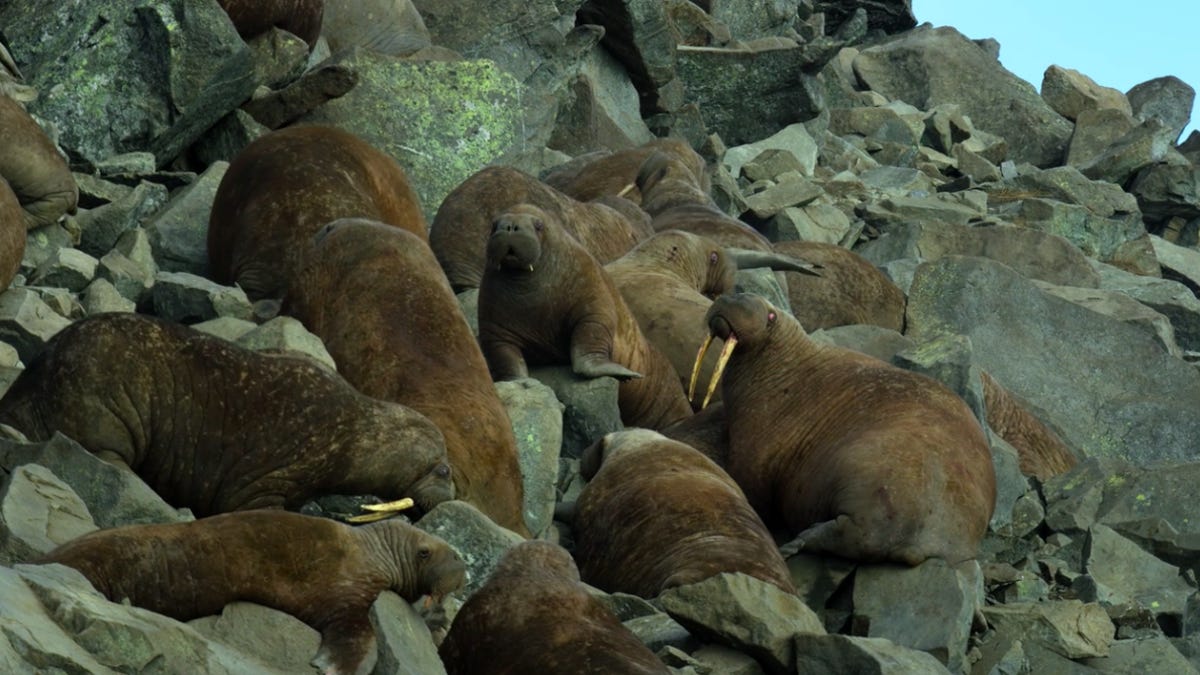
 qz.com
qz.com
The truth.
Personally what I’d like to see are two graph lines. One showing “climate warming” over the last 100 years. The other line population growth. I’d bet they are hand in hand or close. Not to mention so very much more,
bulldozing paradise for parking lots.
just have to use road salt on roads and driveways don’t we??….And like the Morraine whose streams are warming ( lethal to a lot) thanks to deforestation and loss of riparian zones, becoming little more than urinals….like the Don.
What happens to Bambi when there’s no clean water?

 news.wisc.edu
news.wisc.edu
Bunch of holier than thoughs on their non existent moral horses.
Re Polar bears. A yup.
David Attenbough also had a major um faux paus in his planet earth series so many loved slack jawed on Net flux.
pulling at heart string, like Bambi. Could also side bar into anti hunting. And carrying capacity which “environmentalist” seem to just ignore or have no clue about..
heartstrings.

Netflix’s “Our Planet” has made the walrus the new heartbreaking image of climate change
One scene in Netflix's new nature series is really upsetting viewers.
 qz.com
qz.com
The truth.
Personally what I’d like to see are two graph lines. One showing “climate warming” over the last 100 years. The other line population growth. I’d bet they are hand in hand or close. Not to mention so very much more,
bulldozing paradise for parking lots.
just have to use road salt on roads and driveways don’t we??….And like the Morraine whose streams are warming ( lethal to a lot) thanks to deforestation and loss of riparian zones, becoming little more than urinals….like the Don.
What happens to Bambi when there’s no clean water?

Study finds that not even the largest lakes in the world are safe from salt
Researchers used water quality data and computer models to analyze the amount of salt being carried into Lake Michigan by 234 different tributaries, from major rivers to tiny streams.
Bunch of holier than thoughs on their non existent moral horses.
Last edited:
If you read the article that CM's post referred to it looked at why polar bears became the favourite subject of deniers, not activists.It’s funny how alarmist ( and others) go silent and or use deflections….Almost like a parody of the house these days…
Use the google and find it.Personally what I’d like to see are two graph lines. One showing “climate warming” over the last 100 years. The other line population growth. I’d bet they are hand in hand or close. Not to mention so very much more,
Then you can try to claim that genocide is the only answer, if that's where you really want to go.
Remember those good old days when the arctic didn't burn ever summer?
Montana paid her $30,000 to testify on behalf of the oil industry's trial in Montana.
Of course the alarmist bed wetters here will trash Curry's credibility. Cultural Marxism 101.
The state cancelled her testimony, not activists.
Probably because she noted this during her deposition.
At her December deposition, Curry confirmed that she had never conducted research or even reviewed scientific studies on Montana’s climate. Her credibility in these areas, Curry said, derived from her skills as a fast reader, and a “great Googler and finder of information” who is able to “assimilate a lot of information.”
“What I bring to the table is meta expertise,” she said, “something that is increasingly called ‘wicked science.’”

The six big surprises in the Montana youth climate trial » Yale Climate Connections
The state’s headline expert witness’s testimony was canceled — and other twists from the landmark trial.
I thought climate was global not regional Frankie? So why put Montana on trial? What percentage of the global CO2 emissions derive from Montana - likely less than 0.01%. These climate bed wetters are truly a laughing stock.Montana paid her $30,000 to testify on behalf of the oil industry's trial in Montana.
The state cancelled her testimony, not activists.
Probably because she noted this during her deposition.
At her December deposition, Curry confirmed that she had never conducted research or even reviewed scientific studies on Montana’s climate. Her credibility in these areas, Curry said, derived from her skills as a fast reader, and a “great Googler and finder of information” who is able to “assimilate a lot of information.”
“What I bring to the table is meta expertise,” she said, “something that is increasingly called ‘wicked science.’”

The six big surprises in the Montana youth climate trial » Yale Climate Connections
The state’s headline expert witness’s testimony was canceled — and other twists from the landmark trial.yaleclimateconnections.org
Every ton of CO2 that doesn't go in the air counts, kirk.I thought climate was global not regional Frankie? So why put Montana on trial? What percentage of the global CO2 emissions derive from Montana - likely less than 0.01%. These climate bed wetters are truly a laughing stock.
You should look at per capita CO2 emissions to judge whether more should be done, not total.
Its winter in South America right now.
Last edited:

Princeton, MIT Scientists Say EPA Climate Regulations Based on a ‘Hoax’
Two climate scientists say new EPA rules to cut CO2 emissions “will be disastrous for the country, for no scientifically justifiable reason.”
Two Princeton, MIT Scientists Say EPA Climate Regulations Based On A 'Hoax'
MONDAY, AUG 14, 2023 - 09:40 PM
Authored by Kevin Stocklin via The Epoch Times,
Two prominent climate scientists have taken on the Environmental Protection Agency’s (EPA) new rules to cut CO2 emissions in electricity generation, arguing in testimony that the regulations “will be disastrous for the country, for no scientifically justifiable reason.”

A man climbs stairs on day two of the COP 26 United Nations Climate Change Conference at SECC in Glasgow, Scotland, on Nov. 1, 2021. (Ian Forsyth/Getty Images)
Citing extensive data to support their case, William Happer, professor emeritus in physics at Princeton University, and Richard Lindzen, professor emeritus of atmospheric science at Massachusetts Institute of Technology (MIT), argued that the claims used by the EPA to justify the new regulations are not based on scientific facts but rather political opinions and speculative models that have consistently proven to be wrong.
“The unscientific method of analysis, relying on consensus, peer review, government opinion, models that do not work, cherry-picking data and omitting voluminous contradictory data, is commonly employed in these studies and by the EPA in the Proposed Rule,” Mr. Happer and Mr. Lindzen stated. “None of the studies provides scientific knowledge, and thus none provides any scientific support for the Proposed Rule.”
“All of the models that predict catastrophic global warming fail the key test of the scientific method: they grossly overpredict the warming versus actual data,” they stated. “The scientific method proves there is no risk that fossil fuels and carbon dioxide will cause catastrophic warming and extreme weather.”
Climate models like the ones that the EPA is using have been consistently wrong for decades in predicting actual outcomes, Mr. Happer told The Epoch Times. He presented the table below to the EPA to illustrate his point.
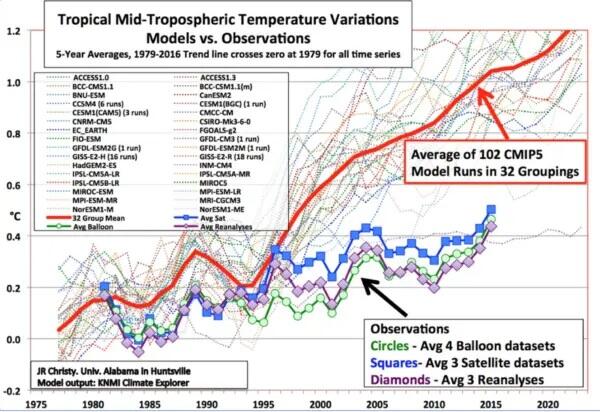
Modeled climate predictions (average shown by red line) versus actual observations (source: J.R. Christy, Univ. of Alabama; KNMI Climate Explorer)
“That was already an embarrassment in the ‘90s, when I was director of energy research in the U.S. Department of Energy,” he said. “I was funding a lot of this work, and I knew very well then that the models were overpredicting the warming by a huge amount.”
He and his colleague argued that the EPA has grossly overstated the harm from CO2 emissions while ignoring the benefits of CO2 to life on Earth.
Many who have fought against EPA climate regulations have done so by arguing what is called the “major questions doctrine,” that the EPA does not have the authority to invent regulations that have such an enormous impact on Americans without clear direction from Congress. Mr. Happer and Mr. Lindzen, however, have taken a different tack, arguing that the EPA regulations fail the “State Farm” test because they are “arbitrary and capricious.”
“Time and again, courts have applied ‘State Farm’s’ principles to invalidate agency rules where the agency failed to consider an important aspect of the problem, or cherry-picked data to support a pre-ordained conclusion,” they stated. The case they referred to is the 2003 case of State Farm v. Campell (pdf), in which the Supreme Court argued that “a State can have no legitimate interest in deliberately making the law so arbitrary that citizens will be unable to avoid punishment based solely upon bias or whim.”
According to Mr. Happer and Mr. Lindzen’s testimony, “600 million years of CO2 and temperature data contradict the theory that high levels of CO2 will cause catastrophic global warming.”
They present CO2 and temperature data indicating much higher levels of both CO2 and temperatures than today, with little correlation between the two. They also argue that current CO2 levels are historically at a low point.
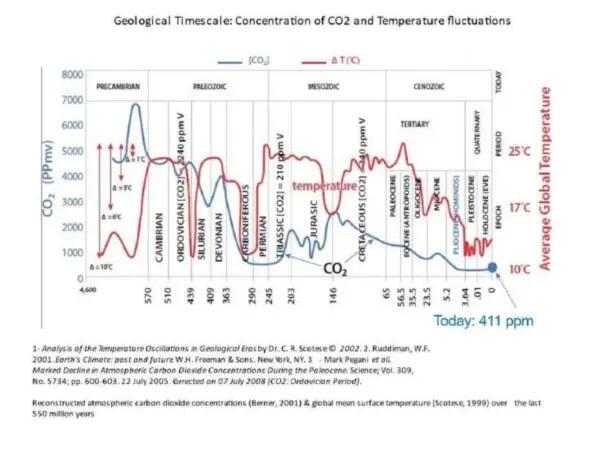
This chart shows CO2 levels (blue) and temperatures (red) over time, indicating little correlation and current levels of both at historic lows. (Source: Analysis of the Temperature Oscillations in Geological Eras by Dr. C. R. Scotese; Earth's Climate: Past and Future by Mark Peganini; Marked Decline in Atmospheric Carbon Dioxide Concentrations During the Paleocene, Science magazine vol. 309.)
“The often highly emphasized 140 [parts per million] increase in CO2 since the beginning of the Industrial Age is trivial compared to CO2 changes over the geological history of life on Earth,” they stated.
In addition, the scientists' testimony to the EPA stated that the agency’s emissions rules fail to consider the fact that CO2 and fossil fuels are essential to life on earth, particularly human life.
“Increased levels of carbon dioxide in the atmosphere create more food for people worldwide, including more food for people in drought-stricken areas,” they stated. “Increases in carbon dioxide over the past two centuries since the Industrial Revolution, from about 280 parts per million to about 420 ppm, caused an approximate 20 percent increase in the food available to people worldwide, as well as increased greening of the planet and a benign warming in temperature.”
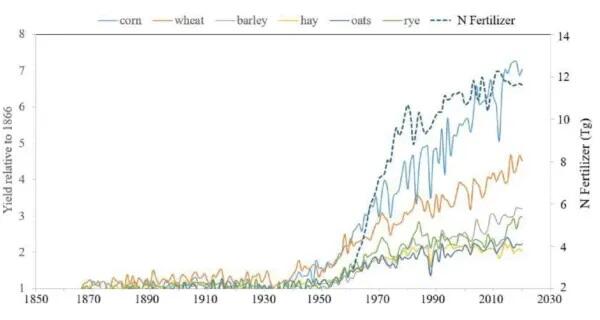
Synthetic fertilizers (dotted line) have increased crop yields dramatically since their introduction. (Source: crop yields from USDA; fertilizer usage from Food Agriculture Organization).
More CO2 in the atmosphere leads to more plant growth and higher farming yields, they argued. In addition, synthetic fertilizers, which are derivatives of natural gas, are responsible for nearly half the world’s food production today. “Net zero” goals would reduce CO2 emissions by more than 40 gigatons per year, reducing the food supply proportionally, they said.
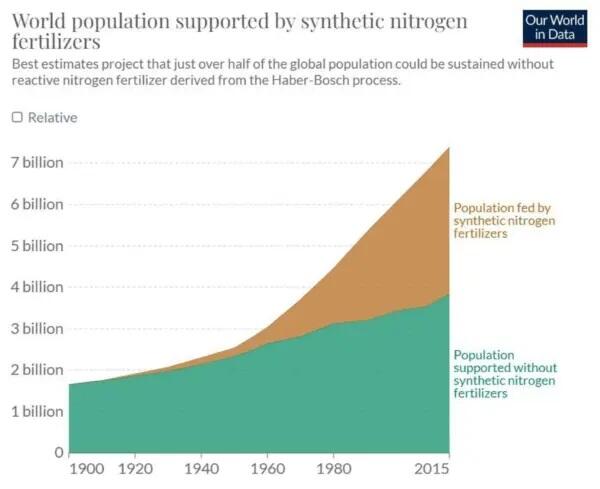
The world's population is increasingly dependent on synthetic fertilizers, a derivative of fossil fuels. (Source: ourworldindata.org)
In addition to disregarding the benefits of CO2, they stated, the EPA’s emission rules and the global warming narrative that has been used to justify them are based on flawed data.
In addition to teaching physics at Princeton, Mr. Happer’s decades of work in physics has focused on atmospheric radiation and atmospheric turbulence, and his inventions have been used by astronomers and in national defense.
“Radiation in the atmosphere is my specialty,” Mr. Happer said, “and I know more about it than, I would guess, any climate scientists.”
His expertise, he said, “involves much of the same physics that’s involved in climate, and none of it is very alarming.”
The global warming narrative argues that as people burn fossil fuels, they emit higher concentrations of carbon dioxide into the earth’s atmosphere, which absorbs sunlight and creates a “greenhouse effect,” trapping the sun’s radiation and warming the earth.
But one aspect of CO2 emissions that global warming models fail to take into account, Mr. Happer said, is a phenomenon called “saturation,” or the diminishing effect of CO2 in the atmosphere at higher concentrations.
“At the current concentrations of CO2, around 400 parts per million, it decreases the radiation to space by about 30 percent, compared to what you would have if you took it all away,” Mr. Happer said. “So that’s enough to cause quite a bit of warming of the earth, and thank God for that; it helps make the earth habitable, along with the effects of water vapor and clouds.”
“But if you could double the amount of CO2 from 400 to 800, and that will take a long time, the amount that you decrease radiation to space is only one percent,” Mr. Happer said. “Very few people realize how hard it is for additional carbon dioxide to make a difference to the radiation to space. That’s what’s called saturation, and it’s been well known for a century.”
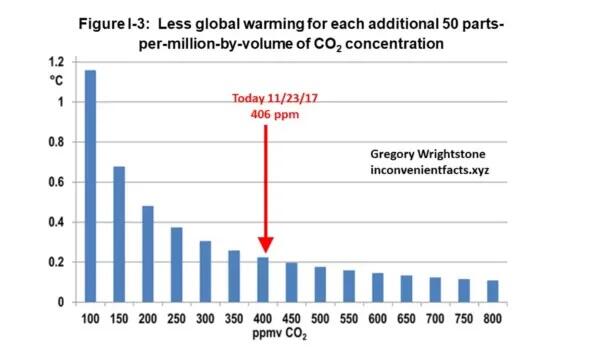
The "greenhouse effect" of additional CO2 does not increase in proportion to the amount of CO2 added (source: William Happer).
In addition to scientific arguments about why global warming is overblown, the scientists also cite data showing large discrepancies between global warming models and actual observations. In some cases, Mr. Happer and Mr. Lindzen say, data has been disingenuously manipulated to fit the climate-change narrative.
“The most striking example of that is the temperature record,” Mr. Happer said. “If you look at the temperature records that were published 20 years ago, they showed very clearly that in the United States by far the warmest years we had were during the mid-1930s.
“If you look at the data today, that is no longer true,” he said. “People in charge of that data, or what the public sees, have gradually reduced the temperatures of the ‘30s, then increased the temperature of more recent measurements.”
An example of misleading data used by the EPA as proof of global warming is shown in the chart below, Mr. Happer and Mr. Lindzen claimed.
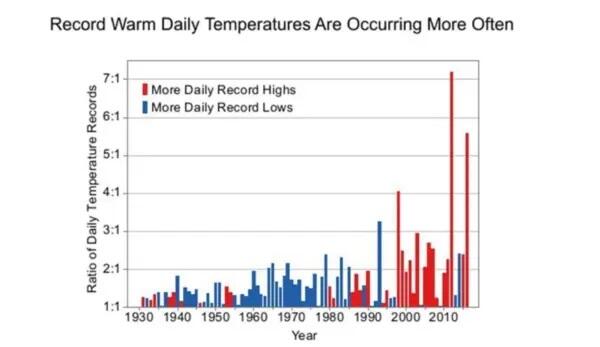
EPA data shows an increasing ratio of daily record high-to-low temperatures in order to indicate rising global temperatures (Source: NOAA/NCEI)
“This chart does not actually show ‘daily temperatures,’” they state. “Instead it show a ‘ratio’ of daily record highs to lows - a number that appears designed to create the impression that temperatures are steadily rising.”
By contrast, the scientists presented the following table, which indicates significantly higher temperatures in the 1930s versus today.
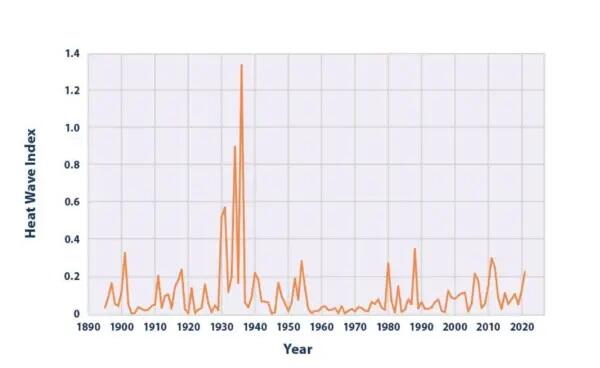
This data indicates that heat waves were more severe in the 1930s than today. (Source: EPA).[/URL]
The Scientific ‘Consensus’ for Climate Change
Proponents of the global warming narrative often state that it is “settled science” and that nearly all scientists agree that global warming is real and the result of human activity.
According to an official NASA statement, “the vast majority of actively publishing climate scientists—97 percent—agree that humans are causing global warming and climate change. Most of the leading science organizations around the world have issued public statements expressing this, including international and U.S. science academies, the United Nations Intergovernmental Panel on Climate Change, and a whole host of reputable scientific bodies around the world.”
A report by Cornell University states that “more than 99.9% of peer-reviewed scientific papers agree that climate change is mainly caused by humans, according to a new survey of 88,125 climate-related studies.”
But Mr. Happer argues that consensus is not science, citing a lecture on the scientific method by renowned physicist Richard Feynman, who said, “if it disagrees with experiment, it’s wrong.”
“Science has never been made by consensus,” Mr. Happer said. “The way you decide something is true in science is you compare it with experiment or observations.
“It doesn’t matter if there’s a consensus; it doesn’t matter if a Nobel Prize winner says it’s true, if it disagrees with observations, it’s wrong,” he said. “And that’s the situation with climate models. They are clearly wrong because they don’t agree with observations.”
The National Library of Medicine cites a speech by physician and author Michael Crichton at the California Institute of Technology in 2003 in which he said, “consensus is the business of politics.”
“Science, on the contrary, requires only one investigator who happens to be right, which means that he or she has results that are verifiable by reference to the real world,” Dr. Crichton said. “In science, consensus is irrelevant. What are relevant are reproducible results.”
“The initial predictions of climate disasters had New York flooded by now, no ice left at the North Pole, England would be like Siberia by now,” Mr. Happer said. “Nothing that they predicted actually came true. You have to do something to keep the money coming in, so they changed ‘global warming’ to ‘climate change.’”
The Price of Dissent
Regarding the consensus in published literature cited by Cornell University, some experts counter that academic publications routinely reject any submissions that question the global warming narrative.
“I’m lucky because I didn’t really start pushing back on this until I was close to retirement,” Mr. Happer said. He had already established himself at that point as a tenured professor at Princeton, a member of the Academy of Sciences, and director of energy research at the U.S. Department of Energy.
“If I’d been much younger, they could have made sure I never got tenure, that my papers would never get published,” he said. “They can keep me from publishing papers now, but it doesn’t matter because I already have status. But it would matter a lot if I were younger and I had a career that I was trying to make.”
In an interview with John Stossel, climate scientist Judith Curry said she paid the price for contradicting the narrative and called the global warming consensus “a manufactured consensus.”
Ms. Curry, the former chair of Georgia Tech’s School of Earth and Atmospheric Sciences, said that when she published a study that claimed hurricanes were increasing in intensity, “I was adopted by the environmental advocacy groups and the alarmists and I was treated like a rock star; I was flown all over the place to meet with politicians and to give these talks, and lots of media attention.”
When several researchers questioned her findings, she investigated their claims and concluded that her critics were correct.
“Part of it was bad data; part of it was natural climate variability,” she said. But when she went public with that fact, she was shunned, she said and pushed out of academia.
Mr. Lindzen tells a similar tale, once he began to question the climate narrative.
“Funding and publication became almost impossible,” he said, “and I was holding the most distinguished chair in meteorology,” which was MIT’s Sloan Professorship of Meteorology.
Nobel Prize-winning physicist John Clauser told The Epoch Times that he, too, was abruptly canceled from giving a speech on climate at the International Monetary Fund (IMF) on July 25.
Mr. Clauser had stated during a previous speech at Quantum Korea 2023 that “climate change is not a crisis.”
He said that climate is a self-regulating process and that more clouds form when temperatures rise, resulting in a compensatory cooling effect. Although he agrees that atmospheric carbon dioxide is increasing, he argued that the gas's effect on global warming is swamped by the natural cloud cycle.
However, only days before his IMF discussion was to take place, Mr. Clauser received an email indicating that the IMF's Independent Evaluation Office (IEO) director, Pablo Moreno, didn't want the event to happen. An assistant who was coordinating the event wrote to Mr. Clauser: “When I arranged this the Director was very happy about it but things have evidently changed.”
The IMF’s current policy on climate change is that “large emitting countries need to introduce a carbon tax that rises quickly to $75 a ton in 2030, consistent with limiting global warming to 2° [Celcius] or less.”
The Climate Money Machine
Asked why there would be a need to censor, alter, and cherry-pick data to support the global warming narrative, Mr. Lindzen said “because it’s a hoax.”
Mr. Clauser said of the climate consensus, “We are totally awash in pseudoscience.”
“There is this huge fraction of the population that has been brainwashed into thinking this is an existential threat to the planet,” Mr. Happer said. “I don’t blame the people; they don’t have the background to know they are being deceived, but they are being deceived.”
The World Bank announced in September 2022 that it paid out a record $31.7 billion that fiscal year to help countries address climate change, a 19 percent increase from the $26.6 billion it paid out over the previous fiscal year. And according to Reuters, the United States is projected to spend about $500 billion to fight climate change over the next decade, including $362 billion from the Inflation Reduction Act, $98 billion from the Infrastructure Act, and $54 billion from the CHIPS law.
“What would happen to sustainable energy, the worthless windmills and solar panels if suddenly there were no climate change emergency,” Mr. Happer said. “They’re really not very good technology and they’re doing a lot more harm than good, but nevertheless people are making lots of money.”
Many investors, most notably BlackRock, the world’s largest asset manager, have cited government regulations and subsidies as a key reason why investments in “green” energies would be profitable.
Research grants to study climate change are offered by many government agencies, including the EPA, the National Institute of Environmental Health Sciences, the National Oceanic and Atmospheric Administration (NOAA), as well as by non-profits including Bloomberg Philanthropies and the MacArthur Foundation, which paid out $458 million since 2014.
“Going back to [19]88 to ’90, funding went up by a factor of 15,” Mr. Lindzen said. “You created a whole new community.
“This was a small field in 1990; not a single member of the faculty at MIT called themselves a climate scientist,” he said. “By 1996, everyone was a climate scientist, and that included impacts. If you’re studying cockroaches and you put in your grant, ‘cockroaches and climate,’ you are a climate scientist.”
Asked to respond to the professors’ comments, an EPA spokesperson stated: “The Agency will review all comments we received as we work to finalize the proposed standards.”
Kevin Stocklin is a business reporter, film producer and former Wall Street banker. He wrote and produced "We All Fall Down: The American Mortgage Crisis," a 2008 documentary on the collapse of the mortgage finance system. His most recent documentary is "The Shadow State," an investigation of the ESG industry.
Last edited:
Lindzen and Happer are clowns.
Princeton, MIT Scientists Say EPA Climate Regulations Based on a ‘Hoax’
Two climate scientists say new EPA rules to cut CO2 emissions “will be disastrous for the country, for no scientifically justifiable reason.”www.theepochtimes.com
Two Princeton, MIT Scientists Say EPA Climate Regulations Based On A 'Hoax'
MONDAY, AUG 14, 2023 - 09:40 PM
Authored by Kevin Stocklin via The Epoch Times,
Two prominent climate scientists have taken on the Environmental Protection Agency’s (EPA) new rules to cut CO2 emissions in electricity generation, arguing in testimony that the regulations “will be disastrous for the country, for no scientifically justifiable reason.”

A man climbs stairs on day two of the COP 26 United Nations Climate Change Conference at SECC in Glasgow, Scotland, on Nov. 1, 2021. (Ian Forsyth/Getty Images)
Citing extensive data to support their case, William Happer, professor emeritus in physics at Princeton University, and Richard Lindzen, professor emeritus of atmospheric science at Massachusetts Institute of Technology (MIT), argued that the claims used by the EPA to justify the new regulations are not based on scientific facts but rather political opinions and speculative models that have consistently proven to be wrong.
“The unscientific method of analysis, relying on consensus, peer review, government opinion, models that do not work, cherry-picking data and omitting voluminous contradictory data, is commonly employed in these studies and by the EPA in the Proposed Rule,” Mr. Happer and Mr. Lindzen stated. “None of the studies provides scientific knowledge, and thus none provides any scientific support for the Proposed Rule.”
“All of the models that predict catastrophic global warming fail the key test of the scientific method: they grossly overpredict the warming versus actual data,” they stated. “The scientific method proves there is no risk that fossil fuels and carbon dioxide will cause catastrophic warming and extreme weather.”
Climate models like the ones that the EPA is using have been consistently wrong for decades in predicting actual outcomes, Mr. Happer told The Epoch Times. He presented the table below to the EPA to illustrate his point.

Modeled climate predictions (average shown by red line) versus actual observations (source: J.R. Christy, Univ. of Alabama; KNMI Climate Explorer)
“That was already an embarrassment in the ‘90s, when I was director of energy research in the U.S. Department of Energy,” he said. “I was funding a lot of this work, and I knew very well then that the models were overpredicting the warming by a huge amount.”
He and his colleague argued that the EPA has grossly overstated the harm from CO2 emissions while ignoring the benefits of CO2 to life on Earth.
Many who have fought against EPA climate regulations have done so by arguing what is called the “major questions doctrine,” that the EPA does not have the authority to invent regulations that have such an enormous impact on Americans without clear direction from Congress. Mr. Happer and Mr. Lindzen, however, have taken a different tack, arguing that the EPA regulations fail the “State Farm” test because they are “arbitrary and capricious.”
“Time and again, courts have applied ‘State Farm’s’ principles to invalidate agency rules where the agency failed to consider an important aspect of the problem, or cherry-picked data to support a pre-ordained conclusion,” they stated. The case they referred to is the 2003 case of State Farm v. Campell (pdf), in which the Supreme Court argued that “a State can have no legitimate interest in deliberately making the law so arbitrary that citizens will be unable to avoid punishment based solely upon bias or whim.”
According to Mr. Happer and Mr. Lindzen’s testimony, “600 million years of CO2 and temperature data contradict the theory that high levels of CO2 will cause catastrophic global warming.”
They present CO2 and temperature data indicating much higher levels of both CO2 and temperatures than today, with little correlation between the two. They also argue that current CO2 levels are historically at a low point.

This chart shows CO2 levels (blue) and temperatures (red) over time, indicating little correlation and current levels of both at historic lows. (Source: Analysis of the Temperature Oscillations in Geological Eras by Dr. C. R. Scotese; Earth's Climate: Past and Future by Mark Peganini; Marked Decline in Atmospheric Carbon Dioxide Concentrations During the Paleocene, Science magazine vol. 309.)
“The often highly emphasized 140 [parts per million] increase in CO2 since the beginning of the Industrial Age is trivial compared to CO2 changes over the geological history of life on Earth,” they stated.
In addition, the scientists' testimony to the EPA stated that the agency’s emissions rules fail to consider the fact that CO2 and fossil fuels are essential to life on earth, particularly human life.
“Increased levels of carbon dioxide in the atmosphere create more food for people worldwide, including more food for people in drought-stricken areas,” they stated. “Increases in carbon dioxide over the past two centuries since the Industrial Revolution, from about 280 parts per million to about 420 ppm, caused an approximate 20 percent increase in the food available to people worldwide, as well as increased greening of the planet and a benign warming in temperature.”

Synthetic fertilizers (dotted line) have increased crop yields dramatically since their introduction. (Source: crop yields from USDA; fertilizer usage from Food Agriculture Organization).
More CO2 in the atmosphere leads to more plant growth and higher farming yields, they argued. In addition, synthetic fertilizers, which are derivatives of natural gas, are responsible for nearly half the world’s food production today. “Net zero” goals would reduce CO2 emissions by more than 40 gigatons per year, reducing the food supply proportionally, they said.

The world's population is increasingly dependent on synthetic fertilizers, a derivative of fossil fuels. (Source: ourworldindata.org)
In addition to disregarding the benefits of CO2, they stated, the EPA’s emission rules and the global warming narrative that has been used to justify them are based on flawed data.
In addition to teaching physics at Princeton, Mr. Happer’s decades of work in physics has focused on atmospheric radiation and atmospheric turbulence, and his inventions have been used by astronomers and in national defense.
“Radiation in the atmosphere is my specialty,” Mr. Happer said, “and I know more about it than, I would guess, any climate scientists.”
His expertise, he said, “involves much of the same physics that’s involved in climate, and none of it is very alarming.”
The global warming narrative argues that as people burn fossil fuels, they emit higher concentrations of carbon dioxide into the earth’s atmosphere, which absorbs sunlight and creates a “greenhouse effect,” trapping the sun’s radiation and warming the earth.
But one aspect of CO2 emissions that global warming models fail to take into account, Mr. Happer said, is a phenomenon called “saturation,” or the diminishing effect of CO2 in the atmosphere at higher concentrations.
“At the current concentrations of CO2, around 400 parts per million, it decreases the radiation to space by about 30 percent, compared to what you would have if you took it all away,” Mr. Happer said. “So that’s enough to cause quite a bit of warming of the earth, and thank God for that; it helps make the earth habitable, along with the effects of water vapor and clouds.”
“But if you could double the amount of CO2 from 400 to 800, and that will take a long time, the amount that you decrease radiation to space is only one percent,” Mr. Happer said. “Very few people realize how hard it is for additional carbon dioxide to make a difference to the radiation to space. That’s what’s called saturation, and it’s been well known for a century.”

The "greenhouse effect" of additional CO2 does not increase in proportion to the amount of CO2 added (source: William Happer).
In addition to scientific arguments about why global warming is overblown, the scientists also cite data showing large discrepancies between global warming models and actual observations. In some cases, Mr. Happer and Mr. Lindzen say, data has been disingenuously manipulated to fit the climate-change narrative.
“The most striking example of that is the temperature record,” Mr. Happer said. “If you look at the temperature records that were published 20 years ago, they showed very clearly that in the United States by far the warmest years we had were during the mid-1930s.
“If you look at the data today, that is no longer true,” he said. “People in charge of that data, or what the public sees, have gradually reduced the temperatures of the ‘30s, then increased the temperature of more recent measurements.”
An example of misleading data used by the EPA as proof of global warming is shown in the chart below, Mr. Happer and Mr. Lindzen claimed.

EPA data shows an increasing ratio of daily record high-to-low temperatures in order to indicate rising global temperatures (Source: NOAA/NCEI)
“This chart does not actually show ‘daily temperatures,’” they state. “Instead it show a ‘ratio’ of daily record highs to lows - a number that appears designed to create the impression that temperatures are steadily rising.”
By contrast, the scientists presented the following table, which indicates significantly higher temperatures in the 1930s versus today.

This data indicates that heat waves were more severe in the 1930s than today. (Source: EPA).[/URL]
The Scientific ‘Consensus’ for Climate Change
Proponents of the global warming narrative often state that it is “settled science” and that nearly all scientists agree that global warming is real and the result of human activity.
According to an official NASA statement, “the vast majority of actively publishing climate scientists—97 percent—agree that humans are causing global warming and climate change. Most of the leading science organizations around the world have issued public statements expressing this, including international and U.S. science academies, the United Nations Intergovernmental Panel on Climate Change, and a whole host of reputable scientific bodies around the world.”
A report by Cornell University states that “more than 99.9% of peer-reviewed scientific papers agree that climate change is mainly caused by humans, according to a new survey of 88,125 climate-related studies.”
But Mr. Happer argues that consensus is not science, citing a lecture on the scientific method by renowned physicist Richard Feynman, who said, “if it disagrees with experiment, it’s wrong.”
“Science has never been made by consensus,” Mr. Happer said. “The way you decide something is true in science is you compare it with experiment or observations.
“It doesn’t matter if there’s a consensus; it doesn’t matter if a Nobel Prize winner says it’s true, if it disagrees with observations, it’s wrong,” he said. “And that’s the situation with climate models. They are clearly wrong because they don’t agree with observations.”
The National Library of Medicine cites a speech by physician and author Michael Crichton at the California Institute of Technology in 2003 in which he said, “consensus is the business of politics.”
“Science, on the contrary, requires only one investigator who happens to be right, which means that he or she has results that are verifiable by reference to the real world,” Dr. Crichton said. “In science, consensus is irrelevant. What are relevant are reproducible results.”
“The initial predictions of climate disasters had New York flooded by now, no ice left at the North Pole, England would be like Siberia by now,” Mr. Happer said. “Nothing that they predicted actually came true. You have to do something to keep the money coming in, so they changed ‘global warming’ to ‘climate change.’”
The Price of Dissent
Regarding the consensus in published literature cited by Cornell University, some experts counter that academic publications routinely reject any submissions that question the global warming narrative.
“I’m lucky because I didn’t really start pushing back on this until I was close to retirement,” Mr. Happer said. He had already established himself at that point as a tenured professor at Princeton, a member of the Academy of Sciences, and director of energy research at the U.S. Department of Energy.
“If I’d been much younger, they could have made sure I never got tenure, that my papers would never get published,” he said. “They can keep me from publishing papers now, but it doesn’t matter because I already have status. But it would matter a lot if I were younger and I had a career that I was trying to make.”
In an interview with John Stossel, climate scientist Judith Curry said she paid the price for contradicting the narrative and called the global warming consensus “a manufactured consensus.”
Ms. Curry, the former chair of Georgia Tech’s School of Earth and Atmospheric Sciences, said that when she published a study that claimed hurricanes were increasing in intensity, “I was adopted by the environmental advocacy groups and the alarmists and I was treated like a rock star; I was flown all over the place to meet with politicians and to give these talks, and lots of media attention.”
When several researchers questioned her findings, she investigated their claims and concluded that her critics were correct.
“Part of it was bad data; part of it was natural climate variability,” she said. But when she went public with that fact, she was shunned, she said and pushed out of academia.
Mr. Lindzen tells a similar tale, once he began to question the climate narrative.
“Funding and publication became almost impossible,” he said, “and I was holding the most distinguished chair in meteorology,” which was MIT’s Sloan Professorship of Meteorology.
Nobel Prize-winning physicist John Clauser told The Epoch Times that he, too, was abruptly canceled from giving a speech on climate at the International Monetary Fund (IMF) on July 25.
Mr. Clauser had stated during a previous speech at Quantum Korea 2023 that “climate change is not a crisis.”
He said that climate is a self-regulating process and that more clouds form when temperatures rise, resulting in a compensatory cooling effect. Although he agrees that atmospheric carbon dioxide is increasing, he argued that the gas's effect on global warming is swamped by the natural cloud cycle.
However, only days before his IMF discussion was to take place, Mr. Clauser received an email indicating that the IMF's Independent Evaluation Office (IEO) director, Pablo Moreno, didn't want the event to happen. An assistant who was coordinating the event wrote to Mr. Clauser: “When I arranged this the Director was very happy about it but things have evidently changed.”
The IMF’s current policy on climate change is that “large emitting countries need to introduce a carbon tax that rises quickly to $75 a ton in 2030, consistent with limiting global warming to 2° [Celcius] or less.”
The Climate Money Machine
Asked why there would be a need to censor, alter, and cherry-pick data to support the global warming narrative, Mr. Lindzen said “because it’s a hoax.”
Mr. Clauser said of the climate consensus, “We are totally awash in pseudoscience.”
“There is this huge fraction of the population that has been brainwashed into thinking this is an existential threat to the planet,” Mr. Happer said. “I don’t blame the people; they don’t have the background to know they are being deceived, but they are being deceived.”
The World Bank announced in September 2022 that it paid out a record $31.7 billion that fiscal year to help countries address climate change, a 19 percent increase from the $26.6 billion it paid out over the previous fiscal year. And according to Reuters, the United States is projected to spend about $500 billion to fight climate change over the next decade, including $362 billion from the Inflation Reduction Act, $98 billion from the Infrastructure Act, and $54 billion from the CHIPS law.
“What would happen to sustainable energy, the worthless windmills and solar panels if suddenly there were no climate change emergency,” Mr. Happer said. “They’re really not very good technology and they’re doing a lot more harm than good, but nevertheless people are making lots of money.”
Many investors, most notably BlackRock, the world’s largest asset manager, have cited government regulations and subsidies as a key reason why investments in “green” energies would be profitable.
Research grants to study climate change are offered by many government agencies, including the EPA, the National Institute of Environmental Health Sciences, the National Oceanic and Atmospheric Administration (NOAA), as well as by non-profits including Bloomberg Philanthropies and the MacArthur Foundation, which paid out $458 million since 2014.
“Going back to [19]88 to ’90, funding went up by a factor of 15,” Mr. Lindzen said. “You created a whole new community.
“This was a small field in 1990; not a single member of the faculty at MIT called themselves a climate scientist,” he said. “By 1996, everyone was a climate scientist, and that included impacts. If you’re studying cockroaches and you put in your grant, ‘cockroaches and climate,’ you are a climate scientist.”
Asked to respond to the professors’ comments, an EPA spokesperson stated: “The Agency will review all comments we received as we work to finalize the proposed standards.”
Kevin Stocklin is a business reporter, film producer and former Wall Street banker. He wrote and produced "We All Fall Down: The American Mortgage Crisis," a 2008 documentary on the collapse of the mortgage finance system. His most recent documentary is "The Shadow State," an investigation of the ESG industry.
October 2018“
Warming of any significance ceased about 20 years ago,” Lindzen claimed in a lecture at the Global Warming Policy Foundation.24
January 2018“
The public in general doesn’t realize that from the point of view of geological history, we are in a CO2famine,” Happer said in an interview with E&E News.21
Yellowknife being evacuated today because of fires.
Morgan Stanley, those commie activists are warning us now too.
While Yellowknife and the NWT burns California is getting ready for a different kind of extreme weather event.
totally normal
totally normal
Bullshit. Even if CO2 was the driver, if China and India aren't going to reduce emissions, anything we do is pointless. It won't affect squat. Except collapse modern western civilization.Every ton of CO2 that doesn't go in the air counts, kirk.
You should look at per capita CO2 emissions to judge whether more should be done, not total.
Its winter in South America right now.
the nazi germany linked eugenics supporting traitors at the Rockefeller foundation(authors of operation lockstep which was used for covid lockdowns and restrictions) backed a climate change lawsuit in Montana







